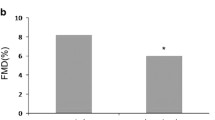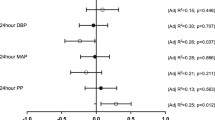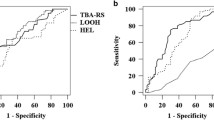Abstract
It is well known the relationship between oxidative stress and vascular function. However, association between total antioxidative capacity and arterial stiffness was not studied in patients with hypertension (HT). This study investigated whether total antioxidative capacity is associated with arterial stiffness and wave reflections. We studied 46 (age 48.5 ± 10.6 years) never treated patients with HT and age-matched control group of 40 (age 47 ± 8.6 years) normotensive individuals. Total antioxidative capacity level was determined in all subjects. We evaluated arterial stiffness and wave reflections of the study population, using applanation tonometry (SphygmoCor). Carotid-femoral pulse-wave velocity (PWV) was measured as index of aortic stiffness. The heart rate-corrected augmentation index (AIx@75) was estimated as a composite marker of wave reflections and arterial stiffness. Carotid-femoral PWV (10.5 ± 2.2 vs 8.7 ± 1.6, m/s, P = 0.0001) and AIx@75 (22.7 ± 9.5 vs 15 ± 11, %, P = 0.001) were significantly higher in patients with HT compared with age-matched control subjects. Total antioxidative capacity level (274 ± 70 vs 321 ± 56 µmol/l, P = 0.001) was significantly lower in hypertensive patients than controls. In the whole population, total antioxidative capacity level negatively correlated with AIx@75 (r = −0.24, P = 0.02) in univariable analysis, but not with carotid-femoral PWV (r = −0.08, P = 0.43). Also, we found that total antioxidative capacity level (β = −0.21, P = 0.03) was an independent determinant of AIx@75 in multivariable analysis. Our results suggest that the decrease in the ability of antioxidant defenses contributes significantly to increased wave reflections.
Similar content being viewed by others
References
Laurent S, Boutouyrie P, Asmar R, Gautier I, Laloux B, Guize L, Ducimetiere P, Benetos A (2001) Aortic stiffness is an independent predictor of all-cause and cardiovascular mortality in hypertensive patients. Hypertension 37:1236–1241
Boutouyrie P, Tropeano AI, Asmar R, Gautier I, Benetos A, Lacolley P, Laurent S (2002) Aortic stiffness is an independent predictor of primary coronary events in hypertensive patients. Hypertension; 39:10–15
Hansen TW, Staessen J, Torp-Pedersen C, Rasmussen S, Thijs L, Ibsen H, Jeppesen J (2006) Prognostic value of aortic pulse wave velocity as index of arterial stiffness in the general population. Circulation 113:664–670
Nemes A, Forster T, Csanady M (2007) Simultaneous echocardiographic evaluation of coronary flow velocity reserve and aortic distensibility indices in hypertension. Heart Vessels 22:73–78
Laurent S, Cockcroft J, Van Bortel L, Boutouyrie P, Giannattasio C, Hayoz D, Pannier B, Vlachopoulos C, Wilkinson I, Struijker-Boudier H (2006) Expert consensus document on arterial stiffness: methodological issues and clinical applications. Eur Heart J 27:2588–2605
Laurent S, Boutouyrie P (2007) Recent advances in arterial stiffness and wave reflection in human hypertension. Hypertension 49:1202–1206
Romero JC, Reckelhoff JF (1999) Role of angiotensin and oxidative stress in essential hypertension. Hypertension 34:943–949
Raij L (1998) Nitric oxide in hypertension: relationship with renal injury and left ventricular hypertrophy. Hypertension 31:189–193
Russo C, Olivieri O, Girelli D, Faccini G, Zenari ML, Lombardi S, Corrocher R (1998) Anti-oxidant status and lipid peroxidation in patients with essential hypertension. J Hypertens 16:1267–1271
Goch A, Lewkowicz P, Tchorzewski H, Goch JH (2004) Serum total antioxidative capacity in patients with essential hypertension. Pol Merkur Lekarski. 17:564–566
Lacy F, O’Connor DT, Schmid-Schonbein GW (1998) Plasma hydrogen peroxide production in hypertensive and normotensive subjects at genetic risk of hypertension. J Hypertens 16:291–303
Young IS, Woodside JV (2001) Antioxidants in health and disease. J Clin Pathol 54:176–186
Kaul N, Siveski-Iliskovic N, Hill M, Slezak J, Singal PK (1993) Free radicals and the heart. J Pharmacol Toxicol Methods 30:55–67
Ghiselli A, Serafini M, Natella F, Scaccini C (2000) Total antioxidant capacity as a tool to assess redox status: critical review and experimental data. Free Radic Biol Med 29:1106–1114
Demirbag R, Yilmaz R, Kunt AS, Gur M, Ulucay A, Unlu D (2006) Relationship between plasma total antioxidant capacity and thoracic aortic intima-media thickness. Echocardiography 23:183–188
Noma K, Goto C, Nishioka K, Jitsuiki D, Umemura T, Ueda K, Kimura M, Nakagawa K, Oshima T, Chayama K, Yoshizumi M, Liao JK, Higashi Y (2007) Roles of rho-associated kinase and oxidative stress in the pathogenesis of aortic stiffness. J Am Coll Cardiol 49:698–705
Chobanian AV, Bakris GL, Black HR, Cushman WC, Green LA, Izzo JL Jr, Jones DW, Materson BJ, Oparil S, Wright JT Jr, Roccella EJ (2003) National Heart, Lung, and Blood Institute Joint National Committee on Prevention, Detection, Evaluation, and Treatment of High Blood Pressure; National High Blood Pressure Education Program Coordinating Committee. The seventh report of the Joint National Committee on Prevention, Detection, Evaluation, and Treatment of High Blood Pressure: the JNC 7 report. JAMA 289:2560–2572
Pauca AL, O’Rourke MF, Kon ND (2001) Prospective evaluation of a method for estimating ascending aortic pressure from the radial artery pressure waveform. Hypertension 38:932–937
Wilkinson IB, MacCallum H, Flint L, Cockcroft JR, Newby DE, Webb DJ (2000) The influence of heart rate on augmentation index and central arterial pressure in humans. J Physiol 525:263–270
Chrysohoou C, Panagiotakos DB, Pitsavos C, Skoumas J, Economou M, Papadimitriou L, Stefanadis C (2007) The association between pre-hypertension status and oxidative stress markers related to atherosclerotic disease: The ATTICA study. Atherosclerosis 192:169–176
Nichols WW, MF O’Rourke (1998) McDonald’s blood flow in arteries: theoretical, experimental and clinical principles. Arnold, London, 170–222
Vlachopoulos C, Dima I, Aznaouridis K, Vasiliadou C, Ioakeimidis N, Aggeli C, Toutouza M, Stefanadis C (2005) Acute systemic inflammation increases arterial stiffness and decreases wave reflection in healthy individuals. Circulation 112:2193–2200
Kelly RP, Millasseau SC, Ritter JM, Chowienczyk PJ (2001) Vasoactive drugs influence aortic augmentation index independently of pulse-wave velocity in healthy men. Hypertension 37:1429–1433
Tsuji T, Mizushige K, Noma T, Murakami K, Miyatake A, Kohno M (2002) Improvement of aortic wall distensibility and reduction of oxidative stress by pioglitazone in pre-diabetic stage of Otsuka Long-Evans Tokushima fatty rats. Cardiovasc Drugs Ther 16: 429–434
Itoh S, Umemoto S, Hiromoto M, Toma Y, Tomochika Y, Aoyagi S, Tanaka M, Fujii T, Matsuzaki M (2002) Importance of NAD(P)H Oxidase-Mediated oxidative stress and contractile type smooth muscle myosin heavy chain SM2 at the early stage of atherosclerosis. Circulation 105:2288–2295
Meyer G, Merval R, Tedgui A (1996) Effects of pressure-induced stretch and convection on low-density lipoprotein and albumin uptake in the rabbit aortic wall. Circ Res 79:532–540
Inoue N, Kawashima S, Hirata KI, Rikitake Y, Takeshita S, Yamochi W, Akita H, Yokoyama M (1998) Stretch force on vascular smooth muscle cells enhances oxidation of LDL via superoxide production. Am J Physiol 274:1928–1932
Di Massimo C, Lo Presti R, Corbacelli C, Pompei A, Scarpelli P, De Amicis D, Caimi G, Tozzi Ciancarelli MG (2006) Impairment of plasma nitric oxide availability in senescent healthy individuals: apparent involvement of extracellular superoxide dismutase activity. Clin Hemorheol Microcirc 35:231–237
Di Massimo C, Scarpelli P, Di Lorenzo N, Caimi G, di Orio F, Ciancarelli MG (2006) Impaired plasma nitric oxide availability and extracellular superoxide dismutase activity in healthy humans with advancing age. Life Sci 9;78:1163–1167
Landmesser U, Drexler H (2007) Endothelial function and hypertension. Curr Opin Cardiol 22:316–320
Harangi M, Remenyik E, Seres I, Varga Z, Katona E, Paragh G (2002) Determination of DNA damage induced by oxidative stress in hyperlipidemic patients. Mutat Res 513:17–25
Negishi H, Ikeda K, Kuga S, Noguchi T, Kanda T, Njelekela M, Liu L, Miki T, Nara Y, Sato T, Mashalla Y, Mtabaji J, Yamori Y (2001) The relation of oxidative DNA damage to hypertension and other cardiovascular risk factors in Tanzania. J Hypertens 19:529–533
Demirbag R, Yilmaz R, Kocyigit A (2005) Relationship between DNA damage, total antioxidant capacity and coronary artery disease. Mutat Res 570:197–203
Demirbag R, Yilmaz R, Gur M, Kocyigit A, Celik H, Guzel S, Selek S (2005) Lymphocyte DNA damage in patients with acute coronary syndrome and its relationship with severity of acute coronary syndrome. Mutat Res 578:298–307
Author information
Authors and Affiliations
Corresponding author
Rights and permissions
About this article
Cite this article
Gedikli, O., Ozturk, S., Yilmaz, H. et al. Low total antioxidative capacity levels are associated with augmentation index but not pulse-wave velocity. Heart Vessels 24, 366–370 (2009). https://doi.org/10.1007/s00380-008-1129-7
Received:
Accepted:
Published:
Issue Date:
DOI: https://doi.org/10.1007/s00380-008-1129-7




